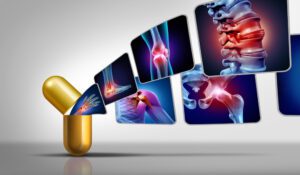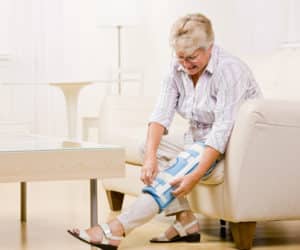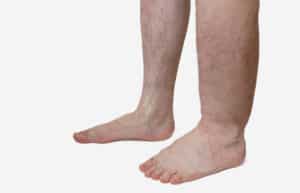Arthritis is a very common disease. In fact, in the United States alone, over 53 million people have arthritis. That’s 23% of the adult population in the country!
But did you know that there are multiple types of arthritis?

To be precise, there are more than 100 different types of arthritis. In this article, we will talk about the 5 most common arthritis types. We will also discuss the signs, symptoms for each. And lastly, we will discuss the treatments available.
5 Most Common Arthritis Types
- Osteoarthritis
- Rheumatoid Arthritis (RA)
- Psoriatic Arthritis
- Gout
- Lupus
Osteoarthritis
This is the most common type of arthritis. It can be described as the “wear and tear” of a person’s joint. Usually, osteoarthritis is caused by aging. However, it can also be caused by obesity and joint injuries.
Usually, it affects knees, hips, feet and the spine. These are where the joints bear the most weight. In osteoarthritis, you don’t feel sick or fatigued.
Signs & Symptoms
- Pain when walking
- Aching pain
- Morning stiffness that usually goes away after 30 minutes or less
- Trouble climbing stairs, bending over, combing your hair, gripping things, and more.
- Stiffness after resting
- Swollen joints
- Warm joints
Treatments
With no cure, the following treatments are recommended for treatment.
- Weight Loss
- More Activity
- Muscle Strengthening Exercises
- Medications
- Support Devices (Canes, etc.)
- Surgery (In some cases)
Rheumatoid Arthritis
This is an autoimmune disease where the immune system attacks certain parts of the body. In rheumatoid arthritis, the immune system weakens the joints.
As a result, the joints can be inflamed and may lead to severe joint damage if left untreated. Usually, it affects the joints in the elbows, heels and knuckles. These are the joints that receive pressure.
Signs & Symptoms
- Swollen joints in one or more parts of the body. This usually happens to the joints in your wrists, hands or feet.
- You may also experience morning stiffness in this type of arthritis. However, compared to osteoarthritis, the morning stiffness here can last for hours. Sometimes, it can go on for a whole day.
- You may also feel fatigued
- Loss of weight
- Decrease in appetite
- Pain and stiffness in hands, knees, ankles, elbows, shoulders, jaw, neck, feet.
Treatments
- Medications
- Self Management Strategies
Treatment for Rheumatoid Arthritis centers on slowing the disease and preventing joint deformity.
Psoriatic Arthritis
This is the type of arthritis where people experience inflammation not only in the joints, but in the skin as well (psoriasis).
People with psoriasis experience patchy red and what areas of the skin that are raised and with scales. Usually, psoriasis affects the scalp, navel, elbows and knees, and around the genital areas.
However, not all who suffer from psoriasis will have psoriatic arthritis. It usually starts between ages 30 and 50. However, it can also start as early as childhood.
Signs & Symptoms
- Swelling fingers and toes
- Pitted or discolored fingernails
- Pain in one or more joints
Treatments
- Medications
- Self Management Strategies
Treatment for Rheumatoid Arthritis centers on slowing the disease and preventing joint deformity.
Gout
Gout is the buildup of uric acid crystals in a joint. This usually happens when your body is making more uric acid, and your kidneys can’t process all of the uric acid. Usually, it happens to different parts of the foot. It may also be caused by other illnesses, eating too much food that raise uric acid levels, drugs, and stress.
A gout attack can last between 3 to 10 days. At first, you may go for months or even years before experiencing another gout. However, the frequency increases as time passes.
Gout can also affect your joints and kidneys if left untreated for too long.
Signs & Symptoms
- Intense joint pain in your big toe, ankles, knees, elbows, wrists or fingers
- Sharp pain in your joints
- Discomfort
- Inflammation and redness on joints
- Stiff joints
Treatments
- Medications (to stop flare ups, which can be extremely painful)
- Long Term Medications
- Diet Adjustments
- Exercise
Lupus
Lupus is another form of autoimmune disease. It can affect the joints and different organs in the body.
As of today, doctors have no clear idea what causes lupus. It is when the immune system attacks the body instead of viruses and other invades.
As a result, lupus may cause inflammation and pain throughout your body. It usually starts from the joints and spreads to the organs. Eventually, the disease will spread to the brain. According to studies, women who are of childbearing age are more likely to get lupus than men.
Signs and Symptoms
- Constant fatigue
- Painful and swollen joints
- Severe headaches
- Mouth sores
- Swelling in the feet, and legs. It can also happen around the eyes
- Rashes across the cheeks
- Hair loss
- Sun sensitivity
- Blue or white fingers when exposed to cold temperatures
- Blood disorders
- Chest pains
Treatments
- Reducing Stress
- Limit Time in The Sun – Other Bright Lights
- Moderate Exercise
- Healthy Foods
- Sleep and Rest
- Medications







